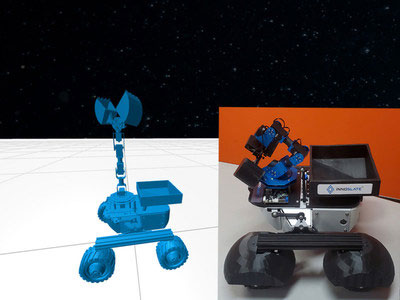Ansys Empowers SPEC Innovations to Shoot for the Moon in NASA Challenge
SPEC Innovations cuts cost and time of developing a digital twin of a lunar rover by 1,000% with Ansys' simulation software, according to company.

SPEC Innovations pairs cloud-based Innoslate with Ansys simulation solutions to achieve digital engineering to design, build, and test a lunar rover. Image courtesy of Ansys.
Latest News
December 7, 2021
SPEC Innovations is applying Ansys simulation solutions to develop a digital twin of a lunar rover to better enable Moon excavation in response to NASA's Break the Ice Lunar Challenge.
With Ansys' tools, SPEC Innovations devised a cloud native, cost-effective solution to the innovation challenge, which aims to inspire new technologies to help establish a consistent human presence on the Moon by 2030. To operate on the Moon, robotic systems must withstand brutal environments in dark, shadowed regions of the lunar south pole, while canvassing its surface for water.
By integrating its cloud-based web application Innoslate with Ansys SpaceClaim 3D modeling software and AGI Systems Tool Kit (STK) analysis platform, SPEC Innovations reached primary goals through digital engineering; these goals include excavating icy regolith and increasing water mining, while minimizing equipment and power consumption. Further, by leveraging Ansys, SPEC Innovations was able to validate mission processes during design analysis and substantially reduce time and cost.
“Ansys SpaceClaim allowed SPEC Innovations to cut cost and time by 1,000%,” says Steven H. Dam, Ph.D., ESEP, president and chief operating officer at SPEC Innovations. “It enabled a rapid modification of the commercial-off-the-shelf (COTS) rover to enable the addition of key components, including a robot arm, collection bin, and fenders, using an inexpensive 3D printer. Such development would have been cost prohibitive if developed by other methods.”
Innoslate offers cloud computing, artificial intelligence (AI) technology and functionalities including project management to complete the digital thread experience within a single model-based systems engineering (MBSE) tool.
“Digital engineering and digital twins are the next phase of innovation in our world,” says Prith Banerjee, chief technology officer at Ansys. “And by leveraging things like AI, machine learning (ML), and cloud computing, simulation is at the forefront of space exploration with more potential than ever to impact product innovation—from Earth to the Moon and beyond.”
NASA's Break the Ice Lunar Challenge program conducted its first phase, which focused on system architecture innovation, from November 2020 through August 2021. Its second phase, once initiated, will focus on designing and validating systems.
Sources: Press materials received from the company and additional information gleaned from the company’s website.
More Ansys Coverage
Subscribe to our FREE magazine, FREE email newsletters or both!
Latest News
About the Author
DE’s editors contribute news and new product announcements to Digital Engineering.
Press releases may be sent to them via [email protected].






